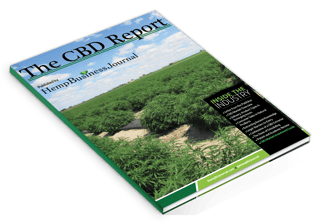The CBD sector is growing at an exponential rate. If you've walked an industry trade show recently, you've certainly noticed an increasing array of CBD-infused products, and your local dispensary has likely also stocked up. Cannabidiol—CBD—is a phytocannabinoid that has significant medical benefits, but does not make people feel “stoned” and can actually counteract the psychoactivity of THC. The fact that CBD-rich cannabis is non-psychoactive or less psychoactive than THC-dominant strains makes it an appealing option for patients looking for relief from inflammation, pain, anxiety, psychosis, seizures, spasms, and other conditions without disconcerting feelings of lethargy or dysphoria. CBD products include oils, tinctures and vaporizer kits.
To understand the opportunities offered in the CBD market, two Canopy portfolio companies – Hemp Business Journal and BDS Analytics - joined forces to analyze the sale of CBD products in dispensaries. For the purposes of their reporting, Hemp Business Journal considered sales of CBD-containing products that are both defined as “industrial hemp” and “marijuana” which are grown under different licenses. The following is an excerpt from The CBD Report.
Channel Sales Analysis
The Dispensary Channel – Hemp and Marijuana Comingle
BDS Analytics tracks whether flowers, concentrates or finished-good products are labeled as containing any level of CBD. This can quickly become a significant portion of the cannabis market with suppliers reporting as little as .01 percent CBD content by dry weight for cannabis flowers. Because marijuana flowers with such low CBD levels have no compelling relevance to the CBD market, HBJ only considered flowers containing at least 1% CBD to be CBD-based products. In 2015, BDS tracked a total of $25.1 million in flower and branded-product sales combined that met this CBD content criteria. Through May 2016, $15.4 million in sales had been recorded.
While HBJ is focused on the hemp market, for this CBD discussion, HBJ felt it important to look at all the significant ways in which CBD is being purchased by consumers. As such, HBJ divided the CBD-containing products sold in the Dispensary Channel (which met our 1 percent cutoff criteria) into four different reporting categories.
While HBJ analyzed BDS reported sales according to these category designations in this report, the following four categories come from HBJ and are not categories you will find in BDS reporting:
- NO THC: These are products with no significant THC levels (less than 0.3 percent dry weight or no labeled THC in branded products) such that they technically meet the requirements to be defined as hemp (though products may have been grown under marijuana licenses). These are typically branded products that contain no THC, are under 0.3 percent THC and may be labeled as hemp extract or containing phytocannabinoids.
- In Colorado and Washington, BDS Analytics tracked $2.6 million in sales in this category in 2015.
- HIGH CBD: A product with a high percentage of CBD relative to THC. These products are purchased because of CBD benefits but they don’t count as hemp because the THC level is significantly over 0.3 percent. Products in this category have a CBD:THC ratio of at least 4:1.
- Sales of High CBD products in Colorado and Washington dispensaries were tracked by BDS Analytics at only $1.2 million in 2015.
- HIGH THC: A product with a very high percentage of THC in relation to CBD. CBD flowers and branded products where the CBD:THC ratio is less than 1:2 are included here.
- BDS Analytics tracked $15.0 million in sales in this category for 2015, with the majority of the sales coming from flowers sold in Colorado adult-use dispensaries.
- VARIABLE: CBD products containing THC at a CBD:THC ratio that doesn’t fall be-tween the 4:1 and 1:2 ratios used for the other categories.
- A CBD:THC ratio of 1:1 is very popular for branded products. In fact, 100 per-cent of the variable branded products sales tracked by BDS use a 1:1 ratio. In total, BDS tracked $6.1 million in sales in this category for 2015.
For comparison to the CBD market, BDS tracked $1.4 billion in total dispensary sales in Colorado and Washington in 2015. Based then on a review of total U.S. cannabis sales as reported by ArcView Market Research, HBJ estimated the total CBD sales in dispensaries across the U.S. in 2015 to be $123 million. Further, HBJ estimates that dispensary sales of CBD products will grow to $1.6 billion in sales by 2020.
This blog post is an excerpt from The CBD Report, the first comprehensive market overview to define and analyze the acceleration of the emerging CBD market category. The CBD Report features the first ever analysis across consumer sales in seven consumer channels including Dispensaries, Natural and Specialty Retail, Mass Market, Practitioner, Internet, Smoke/Head Shops and Pharmaceuticals. Want to learn more about CBDs? Check out The CBD Report today.



